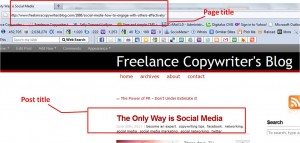Entries Tagged 'search engine optimisation' ↓
July 15th, 2011 — search engine optimisation, seo, SEO copywriter, seo website copywriter
 There’s a lot of great SEO copywriting out there but there’s a lot of bad stuff too.
There’s a lot of great SEO copywriting out there but there’s a lot of bad stuff too.
Once upon a time it was considered that the only way to get your website to rank well was to create content that was purely targeted for the search engines. Inevitably, this resulted in a mountain of websites (and articles) that were stuffed to the rafters with keywords rendering the text unreadable.
Such as:
Brian is an SEO copywriter. He has been working with SEO clients for many years and excels in producing SEO copywriting that works. Through SEO copywriting he gains exceptional rankings for his clients. His SEO copywriting skills have been applauded the world over with his SEO clients the first to recommend his talents. “SEO is the way forward” said Brian, “SEO is what helps my clients get in front of their customers. Without SEO many didn’t get great online sales but now I have worked on their SEO copywriting they are getting more traffic.”
Yuk.
The sad thing is there are still a lot of people out there who think this works.
As more and more people realise that content marketing (articles, blogs and website copy) is the best way to get noticed, more and more badly written content is appearing.
If you want your content to get ranked and attract readers, here are a few things to bear in mind.
How to get your content read
1. Write for people
You may well be scratching your head thinking “Who else would I be writing for?”
Well most people, who generate content like the example above, don’t write for people. They are writing for the search engines by over stuffing their copy with keywords.
Writing for your reader is the most important thing. Naturally, you will include your keywords anyway so there’s no need to stuff them into every sentence you write.
2. Don’t be boring
When you try to boost the frequency of your keyword within your article you end up with something repetitive and boring. Plus if great rankings came solely down to the number of keywords you’d included you’ll end up in a ‘frequency war’ to see who can add the most. Therefore nothing that appeared on the web would be readable.
Therefore it is much better to keep your writing natural and concentrate on getting your keywords into other prominent on screen areas.
3. Maximising on screen SEO
To explain that last statement in number 2, the key on screen areas are in your headings (H1 and H2 etc.) and ALT tags for images.
Basically that means breaking down your article by using sub headings.
This not only gives more prominence to your keywords it also makes your article easier and more attractive to read.
Remember, the search engines will read every word of your articles but your reader will skim read and look at the sub headings.
4. Link out
Although you are trying to generate inbound links to your website through your content, it’s always a good idea to link out to other information.
After all, to create your article you would have probably done some research so why not link to it? Providing your reader with this extra information will add value and enhance your status as an expert in your field. And, with a bit of luck, might encourage more inbound links to your site.
5. Be natural
Last but not least, be natural.
As stated in number 1, you have to write for your reader first and foremost. But make sure the way you write is also accessible.
If you write in jargon and industry ‘speak’ you’ll reduce the accessibility of your work. Writing in simple language and in the second person (so you actually address your reader directly) will make it easier to read for everyone.
At the end of the day, natural copy will always do better than obvious SEO stuffing. Use simple language, plenty of sub headings and talk directly to your reader if you want to create content that ranks and is accessible to your reader.
June 22nd, 2011 — copywriting tips, online marketing, Page titles, search engine optimisation, seo, Title tags
When it comes to SEO, your page title is everything.
It is probably the most important search engine optimisation factor as it exists to help the search engine understand what your page is all about. And if it understands that, you’ll appear in the right search engine results pages.
But many people confuse their page title and their post title.
Your post title is exactly that, the name you have given to your blog post. Your page title is usually auto generated and therefore tends to be the same as your post title.

But the key to optimising your SEO is to make these different. Many platforms, such as Word Press, allow you to easily alter your page title to something that will carry more SEO weight.
What does that mean?
Well, to make sure your post comes up in relevant search engine results make sure you include your keywords in the first half of your page title. You will only have 65 characters to play with so make sure you make every one count by creating a page title that is meaningful.
This is something that should be done for any website, not just a blog.
But select your keywords carefully – don’t cram them all into your page title because that won’t make sense. Use the word(s) that’s most relevant to that page and then create something that answers the searchers question.
So, for example, if they were searching for a site to help with dog behavioural problems, a site with a title such as “Dog Behavioural Problems – Advice and training videos” will show that that website probably has the answer they are looking for.
Another common mistake is to repeat the page title in the META Description. Remember your page title is for SEO; your META Description is there to attract the click-through. It should convince the searcher that your site is the one that will help them so make sure it is meaningful.
Getting your page titles (or title tags) right is vital for a successful SEO campaign. After all, if you don’t clearly tell the search engines what your website is about, how can it list you in the appropriate search results?
Open a new page in your browser and open your website or blog. What is your page title? Is it really working as hard as it can?
This simple change really can make a huge different in your website’s effectiveness.
Author: Sally Ormond, professional freelance copywriter with Briar Copywriting.
June 6th, 2011 — copywriting tips, Link Building, search engine optimisation, seo, SEO copywriter
Getting great rankings isn’t just about the structure of your website and its copy. Obviously they both have a major influence but there is also a third element that must be present.
Frequently businesses will fork out for a great website and hire a professional SEO copywriter to ensure their copy is SEO friendly, engaging and customer focused. But once their site is live they just sit back and wait.
That’s when the web designer or copywriter gets a phone call asking why their website isn’t on the front page of Google.
First it takes time for that to happen (it’s not going to be an overnight occurrence), secondly your SEO strategy does not end once your site has gone live. That’s just the beginning.
Make Google love you
Probably the most important aspect of SEO is link building.
They are important because they show Google the relevancy and authority of your website. So the more you have the better.
But that doesn’t mean any old link will do.
The link building process has to be done over time and consistently. But don’t be tempted into taking shortcuts by using link farms or paid link networks. The links coming into your site must be genuine and relevant to your site. Google does check the quality of your links so if they’re not genuine and relevant you could end up with a hefty Google penalty.
Here’s what Google’s Webmaster Tools has to say on the matter:
Link schemes
Your site’s ranking in Google search results is partly based on analysis of those sites that link to you. The quantity, quality, and relevance of links count towards your rating. The sites that link to you can provide context about the subject matter of your site, and can indicate its quality and popularity. However, some webmasters engage in link exchange schemes and build partner pages exclusively for the sake of cross-linking, disregarding the quality of the links, the sources, and the long-term impact it will have on their sites. This is in violation of Google’s Webmaster Guidelines and can negatively impact your site’s ranking in search results. Examples of link schemes can include:
- Links intended to manipulate PageRank
- Links to web spammers or bad neighborhoods on the web
- Excessive reciprocal links or excessive link exchanging (“Link to me and I’ll link to you.”)
- Buying or selling links that pass PageRank
The best way to get other sites to create relevant links to yours is to create unique, relevant content that can quickly gain popularity in the Internet community. The more useful content you have, the greater the chances someone else will find that content valuable to their readers and link to it. Before making any single decision, you should ask yourself the question: Is this going to be beneficial for my page’s visitors?
It is not only the number of links you have pointing to your site that matters, but also the quality and relevance of those links. Creating good content pays off: Links are usually editorial votes given by choice, and the buzzing blogger community can be an excellent place to generate interest.
Once you’ve made your changes and are confident that your site no longer violates our guidelines, submit your site for reconsideration.
Source: Google Webmaster Central
Back link analysis
Your Google rankings will constantly go up and down as your competitors vie for the top spot. Constant link building will help you in the rankings battle, so making use of a back link analysis tool (such as SEO Books free tool) will allow you to check out not only where your links are coming from but also who is linking to your competitors.
Links through content
Another way to grow your links is through content. Writing relevant articles which link back to your website should be part of your SEO strategy.
Plus look for guest blogging opportunities and again link back to your site within your blog post.
Generating links should be seen as part of your marketing strategy. Take the ‘one thing a week’ approach and alternate between creating directory listings, writing and submitting articles and generating blog posts.
Breaking down your link building into manageable chunks in this way will ensure the process is continuous.
What strategies do you have for link building? Why not leave a comment and share your experiences.
May 27th, 2011 — search engine optimisation, seo, social media, social media marketing
David Murton has been helping companies build and maintain their online relationships with customers since 2006. On a more personal note, David is an avid piano and accordion player, drawn especially to music of the classical and romantic periods.
The author’s views are entirely his own and may not reflect the views of FreelanceCopywritersBlog.com. If you are interested in producing a Guest Post for this blog, please get in touch with your ideas.
 Serious SEO services and bloggers realize the importance of using both SEO tools and social media to increase their online visibility. Embracing both methods to enhance recognition is more effective than using either approach alone.
Serious SEO services and bloggers realize the importance of using both SEO tools and social media to increase their online visibility. Embracing both methods to enhance recognition is more effective than using either approach alone.
An event involving Rebecca Black of SEOmoz is a good example of what social media can accomplish. She was unhappy with Verizon Wireless and spoke with a customer service rep to correct the issue, but to no avail. She tweeted her dissatisfaction and promptly received a tweet in return, by a different rep that solved the issue. Social media made that happen because of the connections it creates.
Benefits of SEO
- Link building
- Keyword research
- AdWords
- Analytics
In short, SEO is strategy. Any kind of website can be well-known in certain communities, but without an effective link building campaign spurring traffic, competitive sites who build links see more visibility. Keyword research is an effective aspect of increasing rank, especially thorough long-tail keyword research, contributing to conversion rates. AdWords is paid advertising links. Google Analytics is a robust set of marketing tools that monitors activity and measures everything.
Benefits of Social Campaigns
- Digg
- Reddit
- Stumbleupon
- Blogging networks
- Similar communities
Websites and blogs at the top of the SERPs don’t get there by SEO alone. They have strong communal ties, discussion boards and other interactive aspects. Social news websites like Digg, Reddit and Stumbleupon allow the dissemination and sharing of links to content, as well as commenting and voting.
The Left Brain / Right Brain Approach
Lefty:
SEO is the left brain, logically categorizing data. The left brain analyzes website dimensions and metrics, collating all that data to form a strategy that will appease search engine spiders and visitors. “How do I optimize R = S / V?” “I have to increase PS = (N – W) / S!” That is SEO, tactically building an online presence geared a little more toward feeding code to search engines than reaching out to people.
Righty:
Social media is the right brain, seeing the bigger picture. Holistic synthesis is a tool of the right brain, imagining several components working in harmony. Social media is about making new connections, building an online presence that leans more toward sharing with responsive people than churning out code for unfeeling search engines.
Websites can be effective, entertaining or informative with a low rank, and without an SEO strategy in place. Conversely, websites can rank fairly well due to good SEO, yet be ineffective, unfunny or uninformative. Both types of websites do not fare well in the long run. Competitors to such sites lead the way because they implement SEO while leveraging the power of social media to their benefit.
Everyone Benefits
Not long ago, social media and SEO were separate entities, serving different purposes. Once businesses from large corporations to indie labels learned how to generate buzz, social media/cyber-public relations became an effective partner to SEO implementations, essentially fusing with SEO. The goal of social campaigns is brand recognition.
Whether your brand is a product, service, or just you – many times it’s all three – remember that people drive your business. Opening 20 different accounts on social sites and leaving them to gather dust does no good. The social sites themselves add no value to your brand, nor do they generate traffic or revenue. Recognition, traffic and revenue come from people, the new acquaintances made during a social campaign. Like building links, a social campaign is promotion that’s done offsite. Also like link building, a strong social campaign is an ongoing process rather than a quick remedy.
1. Use SEO to tweak code, enhance conversion rates and increase search visibility.
2. Add social campaigns to drive more traffic to your well-oiled machine.
3. Reap the rewards.
May 18th, 2011 — copywriting tips, email marketing, newsletter, search engine optimisation, seo, website copywriting
 Is yours one of the many businesses out there that sends regular newsletters to your customers?
Is yours one of the many businesses out there that sends regular newsletters to your customers?
You probably spend hours slaving over the content (or get a copywriter to slave away for you) to ensure your message is spot on, you’re offering your readers great information and, of course, the odd offer to encourage them to buy from you.
So what happens once it’s been sent?
If you just broadcast it, forget it and then move on to the next month’s issue you’re missing a HUGE opportunity.
Shall I tell you why?
Using your newsletters to boost your SEO
Let me tell you something about your newsletters.
You already have a strong subject line/header, your content will be SEO friendly (stands to reason as you’re writing about your company, products and services) and it’s original content.
So why not breathe life into your newsletter once it’s been sent rather than forgetting about it?
Placing it within your website will help your SEO no end because you’ll be feeding the Google Monster fresh, original content each and every month – yum.
Of course, you can’t just cut and paste the content into your website; you’ll need to make a few amendments such as:
- Create a new page for each newsletter, so you’ll be treating them like articles.
- Use links within the text (hyperlinks using your keywords) to point to other relevant information within your site or other articles.
- Remove any mentioned of forthcoming events etc. Unlike your newsletter which is transient, your new web page will be around for a long time to come.
- Take out any special offers for subscribers.
- Play around with the layout to make sure it looks attractive. Add sub headings, images and even video to enhance your message.
By repurposing the content in this way you’ll add volume to your website, boost your SEO and offer your readers some great information.
 There’s a lot of great SEO copywriting out there but there’s a lot of bad stuff too.
There’s a lot of great SEO copywriting out there but there’s a lot of bad stuff too.
 Serious
Serious  Is yours one of the many businesses out there that sends regular newsletters to your customers?
Is yours one of the many businesses out there that sends regular newsletters to your customers?




